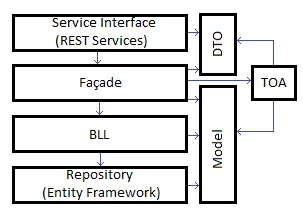我让您看看我的架构: 在每个级别上,我都会在类的构造函数中注入我的
context。外观模式:
public class PublicAreaFacade : IPublicAreaFacade, IDisposable
{
private UnitOfWork _unitOfWork;
public PublicAreaFacade(IDataContext context)
{
_unitOfWork = new UnitOfWork(context);
}
}
业务逻辑层:
public abstract class BaseManager
{
protected IDataContext Context;
public BaseManager(IDataContext context)
{
this.Context = context;
}
}
仓库:
public class Repository<TEntity>
where TEntity : class
{
internal PublicAreaContext _context;
internal DbSet<TEntity> _dbSet;
public Repository(IDataContext context)
{
this._context = context as PublicAreaContext;
}
}
IDataContext是一个接口,由我的DbContext实现:
public partial class PublicAreaContext : DbContext, IDataContext
现在,我如何模拟
EF并编写测试:[TestInitialize]
public void Init()
{
this._mockContext = ContextHelper.CreateCompleteContext();
}
ContextHelper.CreateCompleteContext()的含义是:
public static PublicAreaContext CreateCompleteContext()
{
//Here I mock my context
var mockContext = new Mock<PublicAreaContext>();
//Here I mock my entities
List<Customer> customers = new List<Customer>()
{
new Customer() { Code = "123455" }, //Customer with no invoice
new Customer() { Code = "123456" }
};
var mockSetCustomer = ContextHelper.SetList(customers);
mockContext.Setup(m => m.Set<Customer>()).Returns(mockSetCustomer);
...
return mockContext.Object;
}
这是我编写测试的方式:
[TestMethod]
public void Success()
{
#region Arrange
PrepareEasyPayPaymentRequest request = new PrepareEasyPayPaymentRequest();
request.CodiceEasyPay = "128855248542874445877";
request.Servizio = "MyService";
#endregion
#region Act
PublicAreaFacade facade = new PublicAreaFacade(this._mockContext);
PrepareEasyPayPaymentResponse response = facade.PrepareEasyPayPayment(request);
#endregion
#region Assert
Assert.IsTrue(response.Result == it.MC.WebApi.Models.ResponseDTO.ResponseResult.Success);
#endregion
}
这里看起来一切都正常!我的架构似乎也是正确的。但是,如果我想要插入/更新实体怎么办?什么都不再起作用了!我来解释一下原因:
如您所见,我将一个*Request对象(即DTO)传递给门面,然后在我的TOA中从DTO的属性生成实体:
private PaymentAttemptTrace CreatePaymentAttemptTraceEntity(string customerCode, int idInvoice, DateTime paymentDate)
{
PaymentAttemptTrace trace = new PaymentAttemptTrace();
trace.customerCode = customerCode;
trace.InvoiceId = idInvoice;
trace.PaymentDate = paymentDate;
return trace;
}
PaymentAttemptTrace是我要插入到Entity Framework中的实体。它不是模拟的,我也无法注入它。因此,即使我传递了模拟上下文(IDataContext),当我尝试插入一个未模拟的实体时,我的测试就会失败!
这引发了我对自己是否有错误架构的疑问!
那么,是架构有问题还是我使用moq的方式有问题?
感谢您的帮助。
更新:
以下是我如何测试我的代码。例如,我想测试一笔付款的跟踪记录。
以下是测试代码:
[TestMethod]
public void NoPaymentDate()
{
TracePaymentAttemptRequest request = new TracePaymentAttemptRequest();
request.AliasTerminale = "MyTerminal";
//...
//I create my request object
//You can see how I create _mockContext above
PublicAreaFacade facade = new PublicAreaFacade(this._mockContext);
TracePaymentAttemptResponse response = facade.TracePaymentAttempt(request);
//My asserts
}
这里是外观:
public TracePaymentAttemptResponse TracePaymentAttempt(TracePaymentAttemptRequest request)
{
TracePaymentAttemptResponse response = new TracePaymentAttemptResponse();
try
{
...
_unitOfWork.PaymentsManager.SavePaymentAttemptResult(
easyPay.CustomerCode,
request.CodiceTransazione,
request.EsitoPagamento + " - " + request.DescrizioneEsitoPagamento,
request.Email,
request.AliasTerminale,
request.NumeroContratto,
easyPay.IdInvoice,
request.TotalePagamento,
paymentDate);
_unitOfWork.Commit();
response.Result = ResponseResult.Success;
}
catch (Exception ex)
{
response.Result = ResponseResult.Fail;
response.ResultMessage = ex.Message;
}
return response;
}
这是我开发PaymentsManager的过程:
public PaymentAttemptTrace SavePaymentAttemptResult(string customerCode, string transactionCode, ...)
{
//here the problem... PaymentAttemptTrace is the entity of entity framework.. Here i do the NEW of the object.. It should be injected, but I think it would be a wrong solution
PaymentAttemptTrace trace = new PaymentAttemptTrace();
trace.customerCode = customerCode;
trace.InvoiceId = idInvoice;
trace.PaymentDate = paymentDate;
trace.Result = result;
trace.Email = email;
trace.Terminal = terminal;
trace.EasypayCode = transactionCode;
trace.Amount = amount;
trace.creditCardId = idCreditCard;
trace.PaymentMethod = paymentMethod;
Repository<PaymentAttemptTrace> repository = new Repository<PaymentAttemptTrace>(base.Context);
repository.Insert(trace);
return trace;
}
最终我如何编写代码库:
public class Repository<TEntity>
where TEntity : class
{
internal PublicAreaContext _context;
internal DbSet<TEntity> _dbSet;
public Repository(IDataContext context)
{
//the context is mocked.. Its type is {Castle.Proxies.PublicAreaContextProxy}
this._context = context as PublicAreaContext;
//the entity is not mocked. Its type is {PaymentAttemptTrace} but should be {Castle.Proxies.PaymentAttemptTraceProxy}... so _dbSet result NULL
this._dbSet = this._context.Set<TEntity>();
}
public virtual void Insert(TEntity entity)
{
//_dbSet is NULL so "Object reference not set to an instance of an object" exception is raised
this._dbSet.Add(entity);
}
}
